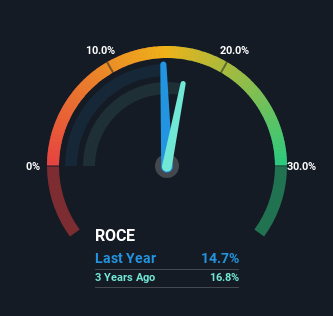Investors Could Be Concerned With Groundhog's (TWSE:6906) Returns On Capital
What trends should we look for it we want to identify stocks that can multiply in value over the long term? Ideally, a business will show two trends; firstly a growing return on capital employed (ROCE) and secondly, an increasing amount of capital employed. Ultimately, this demonstrates that it's a business that is reinvesting profits at increasing rates of return. In light of that, when we looked at Groundhog (TWSE:6906) and its ROCE trend, we weren't exactly thrilled.
What Is Return On Capital Employed (ROCE)?
For those that aren't sure what ROCE is, it measures the amount of pre-tax profits a company can generate from the capital employed in its business. Analysts use this formula to calculate it for Groundhog:
Return on Capital Employed = Earnings Before Interest and Tax (EBIT) ÷ (Total Assets - Current Liabilities)
0.15 = NT$128m ÷ (NT$1.1b - NT$240m) (Based on the trailing twelve months to June 2024).
Therefore, Groundhog has an ROCE of 15%. By itself that's a normal return on capital and it's in line with the industry's average returns of 15%.
View our latest analysis for Groundhog

Historical performance is a great place to start when researching a stock so above you can see the gauge for Groundhog's ROCE against it's prior returns. If you're interested in investigating Groundhog's past further, check out this free graph covering Groundhog's past earnings, revenue and cash flow.
What Can We Tell From Groundhog's ROCE Trend?
We weren't thrilled with the trend because Groundhog's ROCE has reduced by 57% over the last four years, while the business employed 164% more capital. Usually this isn't ideal, but given Groundhog conducted a capital raising before their most recent earnings announcement, that would've likely contributed, at least partially, to the increased capital employed figure. Groundhog probably hasn't received a full year of earnings yet from the new funds it raised, so these figures should be taken with a grain of salt.
On a related note, Groundhog has decreased its current liabilities to 22% of total assets. So we could link some of this to the decrease in ROCE. Effectively this means their suppliers or short-term creditors are funding less of the business, which reduces some elements of risk. Since the business is basically funding more of its operations with it's own money, you could argue this has made the business less efficient at generating ROCE.
The Bottom Line On Groundhog's ROCE
In summary, despite lower returns in the short term, we're encouraged to see that Groundhog is reinvesting for growth and has higher sales as a result. Furthermore the stock has climbed 29% over the last year, it would appear that investors are upbeat about the future. So should these growth trends continue, we'd be optimistic on the stock going forward.
On a final note, we've found 3 warning signs for Groundhog that we think you should be aware of.
While Groundhog may not currently earn the highest returns, we've compiled a list of companies that currently earn more than 25% return on equity. Check out this free list here.
New: Manage All Your Stock Portfolios in One Place
We've created the ultimate portfolio companion for stock investors, and it's free.
• Connect an unlimited number of Portfolios and see your total in one currency
• Be alerted to new Warning Signs or Risks via email or mobile
• Track the Fair Value of your stocks
Have feedback on this article? Concerned about the content? Get in touch with us directly. Alternatively, email editorial-team (at) simplywallst.com.
This article by Simply Wall St is general in nature. We provide commentary based on historical data and analyst forecasts only using an unbiased methodology and our articles are not intended to be financial advice. It does not constitute a recommendation to buy or sell any stock, and does not take account of your objectives, or your financial situation. We aim to bring you long-term focused analysis driven by fundamental data. Note that our analysis may not factor in the latest price-sensitive company announcements or qualitative material. Simply Wall St has no position in any stocks mentioned.
About TWSE:6906
Flawless balance sheet and slightly overvalued.
Market Insights
Community Narratives



